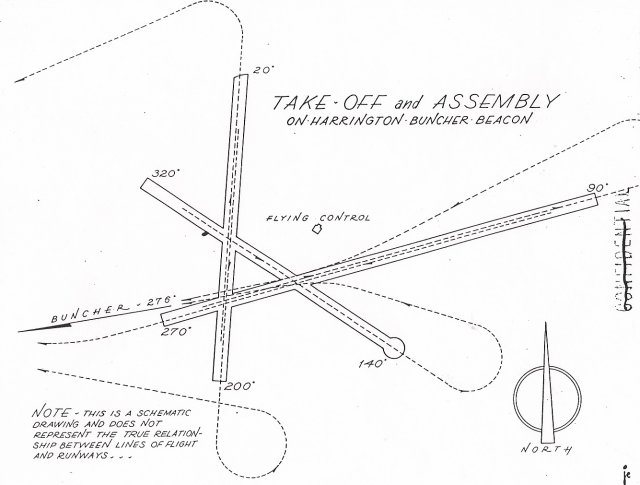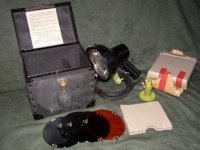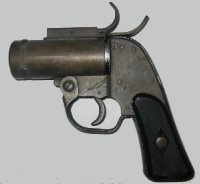 |
Standard Operating Procedure Take-off and Assembly |
Personnel
Mission Reports
Crew Composition
Intelligence
HEADQUARTERS
303RD BOMBARDMENT GROUP (H)
APO 557, U.S. ARMY
15 October 1944

TAKE OFF AND ASSEMBLY PATTERNS FROM MOLESWORTH RUNWAYS
USING THE HARRINGTON BUNCHER BEACON AS A NAVIGATIONAL AID
- NORMAL: PLAN "A"
- Take-off will be made at 30 second intervals for all aircraft in the Group. The Co-Pilot will check time and notify the Pilot when the aircraft ahead has ben moving 30 seconds. Take-off on all runways will be made in a medium tail low position. A medium tail low position is that position between a tail high and a 3 point take-off.
- Flight Leader will climb at 150 I.A.S. and at 400 FPM straight ahead for 90 seconds from the time the aircraft started from take-off position, then make a needle width turn to the left, fly back to the field circling the East-West runway to the left at 2000 feet altitude.
- Wing men will turn inside Flight Leaders to accomplish "join-up." Right wing men will fly under Leader for "Join-up."
- As soon as flights are in formation, leaders will assemble flights into sections and the sections into Squadrons by turning inside the Squadron leaders. Assembly of the Squadron will be at 2000 feet for the lead Squadron at 150 I.A.S. until Squadron has formed.
- The High and Low Squadrons will assemble in the same manner at 3000 and 1000 feet respectively.

Aldis Lamp - Tail gunners will be in the tail of each aircraft flashing the letter "C" with Aldis lamp, from take-off until assembly is completed. The above procedure also will be employed anytime there are reduced visibility conditions or darkness exists.
- On all practice and operational missions the following Aldis lamp signal is to be used by all aircraft in this Group:
ALDIS LETTER: "C" COLOR: WHITE
When it is necessary for more than one Squadron to take-off, they will take-off in the following order:1st - Lead Squadron
2nd - High Squadron
3rd - Low SquadronEvery effort will be made at the assembly point for Wing aircraft to assemble as soon as possible on element leaders and once assembled to hold their correct position. If the assembly is to be made below 7000 feet, the High Squadron may take-off first, the Lead Squadron second and the Low Squadron third.
- Take-off will be made at 30 second intervals for all aircraft in the Group. The Co-Pilot will check time and notify the Pilot when the aircraft ahead has ben moving 30 seconds. Take-off on all runways will be made in a medium tail low position. A medium tail low position is that position between a tail high and a 3 point take-off.
- PROCEDURE IN CASE OF OVERCAST: PLAN "B"
- Take-off will be as normal except that each A/C will continue for 90 seconds at 150 I.A.S. climbing 400 FPM straight ahead on runway heading, then make needle with turn to the Harrington Buncher Beacon, homing on the Buncher with an air speed of 150 I.A.S. and 400 FPM climb. In the event cloud tops are such tat 303rd aircraft are still in the clouds on reaching Harrington Buncher, climb will be continued until aircraft are in the clear before turning to home on Buncher. At no time will any aircraft make a turn while in an overcast.
- It will be the Pilots responsibility to keep proper interval between aircraft by adhering strictly to an airspeed of 150 I.A.S. and a climb of 400 FPM until assembly on Squadron Leader is completed.
- By holding the radio compass at 90 degrees to the aircraft heading while assembling on Harrington Buncher Beacon, and holding a continuous ½ needle width turn, the aircraft will not orbit a distance greater than 3 miles from the Buncher during assembly.
- When assembling more than one squadron on Harrington Buncher, the Lead Squadron will assemble at the assigned assembly altitude and will circle to the left. The Low and High Squadrons will assemble at an altitude minus and plus 1000 feet respectively, also circling to the left. After departing from the required to fly the best Combat Group formation.
- Every attempt will be made by each individual aircraft to join and fly the correct formation on the Squadron at the assembly point as soon as possible.
- Take-off will be as normal except that each A/C will continue for 90 seconds at 150 I.A.S. climbing 400 FPM straight ahead on runway heading, then make needle with turn to the Harrington Buncher Beacon, homing on the Buncher with an air speed of 150 I.A.S. and 400 FPM climb. In the event cloud tops are such tat 303rd aircraft are still in the clouds on reaching Harrington Buncher, climb will be continued until aircraft are in the clear before turning to home on Buncher. At no time will any aircraft make a turn while in an overcast.
- PROCEDURE IN CASE OF INSTRUMENT TAKE-OFF: PLAN "C"
- The following plan will be in use when there are instrument conditions or when the ceiling is less than 500 feet.
- After take-off the climb will be continued on th take-off runway heading at 150 I.A.S. at 400 FPM, until break through is made and then return by homing on Harrington Buncher Beacon where normal assembly will be made.
- In case the visibility is such tat the Pilot of the aircraft taking off cannot see the proceeding aircraft become airborne, the will start his take-off on a green light signal from the flying control caravan at the end of the runway.
- Every effort will be made by each individual aircraft to join and fly correct formation on the Squadron Leader at the point of assembly as soon as possible.
- The following plan will be in use when there are instrument conditions or when the ceiling is less than 500 feet.
- NIGHT TAKE-OFF AND ASSEMBLY

M-8 Flare Gun- Same as day take-off and assembly except that between sections there will be 500 feet clearance. All sections will fly in the right echelon as close as safety permits until daylight. Squadron assembly will be accomplished as soon as possible on Squadron Leaders.
- Squadron Leaders will fire Squadron flares at regular intervals to aid assembly. Announcement over V.H.F. as to when flares are being fired will be made by Squadron Leaders.
Example: "Hello all Cowboy Able Aircraft this is Cowboy Able Leader Standby for Flares."
"Hello all Cowboy Able Aircraft. "Flares Away."
- Tail gunners will continue to flash a white "C" with their Aldis lamps. Co-Pilots will flash the letter of their aircraft using aircraft identification lights and key in cockpit while taxing out in darkness.
- Same as day take-off and assembly except that between sections there will be 500 feet clearance. All sections will fly in the right echelon as close as safety permits until daylight. Squadron assembly will be accomplished as soon as possible on Squadron Leaders.
By order of the Group Commander
GLYNN F. SHUMAKE
Major, Air Corps
Operations Officer